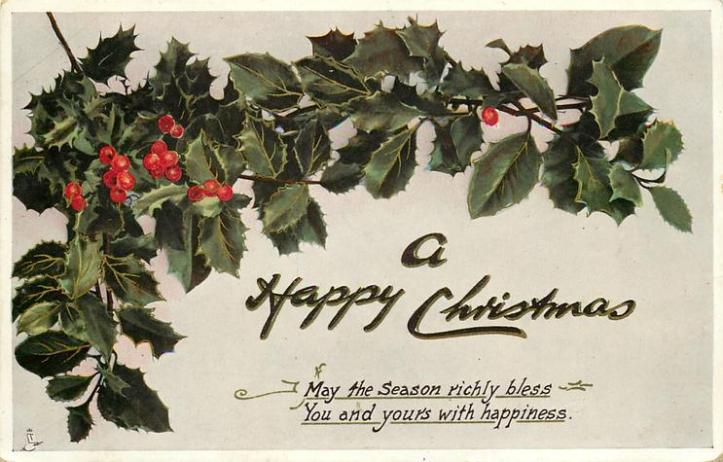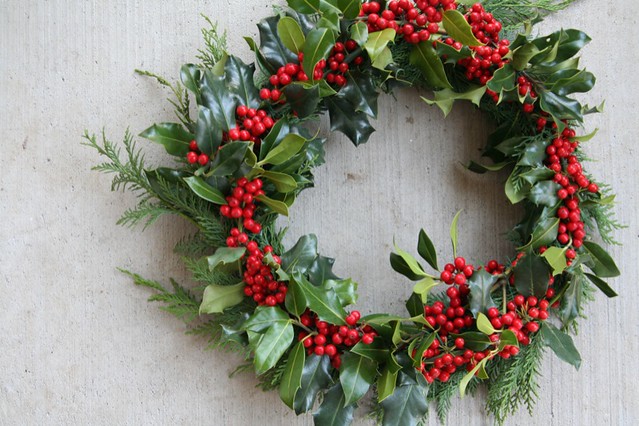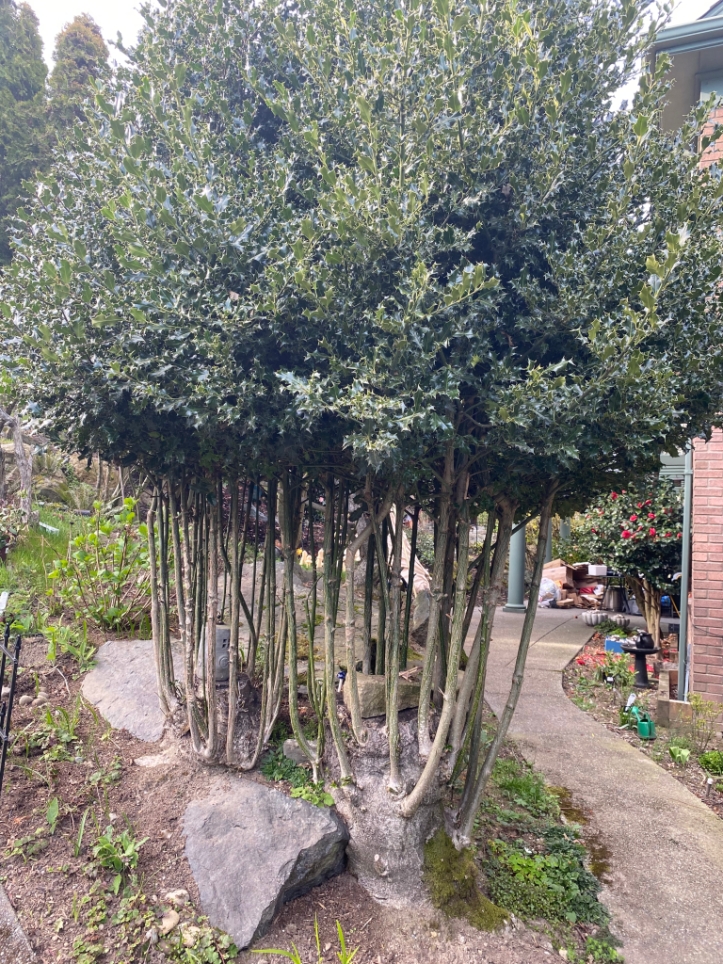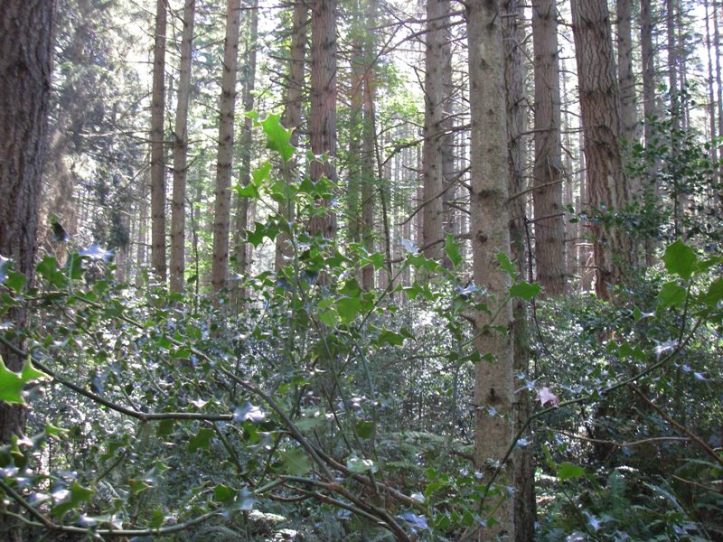Not so jolly-holly?

It’s hard to walk around any local neighborhood without seeing at least one holly tree. English holly’s shiny green leaves and bright red berries stand out among the skeletal remains of trees that have lost their leaves for the winter.
This tall shrub or small tree is often landscaped as a privacy hedge and is grown for production in orchards in the outskirts of the county. Ninety percent of English holly sold in the United States is grown here in the Pacific Northwest (PNW) with the majority of which is exported outside of our region.
English holly (Ilex aquifolium), also known as “Christmas holly,” is a symbol of the joy of wintertime around the world. In Celtic times (~1200 BC) holly plants represented good fortune and beauty. The Celtic habit of decking the halls with “boughs of holly” transformed into the modern traditions of hanging red and green decorations during the holiday season.
So why is this beloved symbol of the holiday season being featured in a noxious weed blog?

Holly’s history
To understand the complexity of English holly’s position in the PNW, we must look deep into its history and the relationships it has formed along the way with people and nature.
The first English holly planting on record in Washington state took place in 1891 – two years after Washington became a state. That’s only 130 years ago, a fairly short time relative to the age of the old-growth forests of this region. Unfortunately, it was only within the past few decades that ecologists, forest owners, and land managers began to grow concerned about the behavior of English holly in our local forests. By the time its negative impact was clear, two generations of families in Washington had been depending on English holly as a crop for their livelihoods.
In 2010, responding to the growing concerns of local scientists, community groups, and land managers, the King County Noxious Weed Control Board recommended to the Washington State Weed Control Board that English holly be added to the noxious weed list as a Class C noxious weed. The goal was to encourage control of escaped holly plants and educate people about its impacts. The county weed board worked with dozens of environmental organizations to put together a pitch that flowed with data and observations regarding how widely English holly had spread within the state. Proposals with support like this only occur when a plant is believed to have significant negative impacts on the natural landscape or agriculture.
Although listing English holly as a noxious weed would not bar holly farmers from selling and distributing the plant, growers were concerned that the negative label as a noxious weed would make holly less appealing and reduce its retail sales. Ultimately, the proposal did not pass. The state weed board felt it needed more hard evidence of the impact of the species, rather than just the quantity, observations, and concerns. Without this evidence, the board didn’t think it was reasonable to negatively impact an agricultural commodity.
Although holly was not listed as a noxious weed, the board did add a statement to the state noxious weed law that gave local governments and county weed boards the authority to educate the public about the potential negative impact of plants that are not on the state noxious weed list. King County lists English holly as a Weed of Concern to encourage control and discourage further plantings in order to prevent it from spreading.
This scenario may seem contradictory. On one hand, holly growers and families rely on the species for their livelihood. On another, scientists and land managers have serious concerns about the plant’s capability to spread and outcompete native plants. So, which option is the right one?
Remember, it’s not the plant itself that is bad. The issue is its negative impact on natural ecosystems. We can work as a community to encourage the removal of unwanted English holly on our properties without harming holly exports.
Behavior and appearance
In appearance, English holly is much like other holly species. It gets its scientific name, Ilex aquifolium, from its leaves. Ilex refers to a species of oak, “holly oak” or Quercus ilex, that has similarly shaped leaves. The word aquifolium is made up of two parts: “acus” meaning needle and “folium” meaning leaf. Leaves are thick, glossy, dark green, and wavy. Leaves usually have sharp spines along the edges (hence the needle leaf), though leaves on older branches may have smooth edges. As an evergreen, leaves remain on the plant year-round. On female trees, bunches of brightly colored berries (red, orange, or yellow) grow from small, white, sweet smelling flowers. Male trees have flowers, but do not form berries. Fruits will only produce seeds if a male tree is close enough to pollinate the female flowers (with the help of bees, of course).
What makes English holly different from others such as American holly, native to the eastern United States, is the combination of its hardiness and ability to spread. English holly can thrive in all types of external conditions. Its berries, a favorite for many birds, can and do grow new plants practically anywhere their seeds are dropped.
Its adaptability, hardiness, and ability to spread are intimidating, but English holly only causes harm when it spreads beyond its intended location and into natural habitats. It adds a dense evergreen tall shrub component to our forests that was absent before, changing the dynamics of the forest habitat. The year-round shade below the tree canopy and dense, thick growth allow holly to outcompete native plants and tree seedlings for space and resources. Once established, holly can form impassable thickets that are very difficult to remove. Wildlife (and humans) have a hard time passing through its matrix of hard wood and spiky leaves.
There are many non-native plants that spread far and wide from their parent plant, but few as difficult to control as English holly. Once established, it is nearly impossible to eradicate mature plants without herbicide. Some methods take months and even years, but there is nothing quite as satisfying as seeing new native plant growth spring up around the base of the old holly frames. With native plants come native insects and animals drawn by age-old connections between flora and fauna. While it seems like the traditions of yesterday are constantly being challenged, information is power and knowing how to protect the land we love for other traditions we value – like hiking, birdwatching and growing flowers and food – is the best outcome possible.
Take action
- Keep supporting local holly farmers! English holly brings joy to many at this time of year and in no way are we encouraging anyone to stop celebrating.
- Think twice before planting English holly in your landscaping, and control what holly you have on your property if it threatens to spread into natural areas.
- Educate yourself about the plants in our landscape and how to manage them. Just by reading this blog post you are taking a step in the right direction.
- Visit the links below for more information on identifying and controlling holly, volunteer with local organizations that support noxious weed control, and most importantly, have a jolly holly-day season.
- Learn more about English holly and share your new knowledge with friends and family
- King County Noxious Weed Control Program page on English holly
- Control English holly on your property:
- Control it yourself:
- Contact us at noxious.weeds@kingcounty.gov for a list of contractors that can help you control the holly on your property.
- Do not plant new English holly plants.
- Volunteer with organizations that work to keep our forests healthy – The Best Volunteer Opportunities in Seattle | VolunteerMatch (keywords “Environmental Restoration”).
- Educate those around you about the complexity of English holly:
- Follow us on Instagram @kingcountyweeds
- Sign up for our newsletter and keep an eye on our blog for new posts: Noxious weeds newsletter sign up – King County.
The rollercoaster history of English holly
A brief historical timeline (with a PNW focus) compiled from resources found in “further reading” section.
Pre-1700
- 1200 BC: The first recorded use of holly as a symbolic winter decoration in Europe.
- Pre-colonialism: Ossabow tribes in the southeastern United States known to brew “holly tea” out of Yaupon holly berries. Holly wood is used for carvings.
- 1620 AD: Pilgrims arrive in what is now Massachusetts with U.S. interest in American holly (Ilex opaca) as Christmas symbolism.
1700s
- Mid-1700s: An increase in business for holly Christmas décor starts to negatively impact the American holly population.
- Late 1700s: English holly brought to the eastern U.S. as a conservation effort to protect the American holly. It was quickly noted that it did not grow well in the east but did thrive in the PNW. This is where the use of English holly in place of American holly for Christmas décor slowly began.
1800s
- 1800s: Recorded that some “pioneers” from the eastern U.S. sent their families Christmas gifts of Oregon grown English holly.
- 1890: Interest in English holly as a profitable crop begins with shipments to California of cut branches from landscapes and small plantings.
- 1891: First commercial English holly on record planted in Puyallup, Washington. Forty trees planted as an orchard for cultivation of holly for winter décor.
1900s
- 1927: Washington Street Society for the Conservation of Wildflowers and Tree Planting (WSSCWT) begins planting and promoting English holly with the goal of making Washington the “Christmas” or “Holly” state.
- 1928: Girl Scouts plant 1,500 small holly trees on Arbor Day in Seward Park.
- 1936: WSSCWT, renamed as the Washington State Conservation Society (WSCS), recognizes English holly as an “exotic plant,” but says it is naturalized and “almost gone native”.
- 1937: Last holly planting in Seward park for Arbor Day; 1000+ children in attendance.
- 1946: Northwest Holly Growers Association founded.
2000s
- 2005: Seward Park Vegetation Management Plan published; determines holly to be the third most common tree in the park after Douglas-fir and big-leaf maple.
- 2006: King County Noxious Weed Board adds English holly to the King County Weeds of Concern list.
- 2007-09: Seattle Public Utilities unsuccessfully attempts to eradicate English holly at Lake Youngs to help mitigate the economic impacts of invasive holly.
- 2010: King County Noxious Weed Control Board makes the proposal to the Noxious Weed Control Board that English holly be added as a class C noxious weed.
- 2011: Proposal is denied but the state noxious weed law is amended to allow county weed boards and other local government to educate about unlisted plants of local concern. A bill is proposed, and denied, that would bar “actively grown commercial crops” in Washington from being added to the state noxious weed list.
- 2012: English holly designated as a Class C nuisance plant in Portland, Oregon. Still allowed to be cultivated and distributed.
- 2021: More than 90% of the English holly sold in the U.S. is grown in the PNW. In Washington there are 4 active commercial farms that specialize in English holly.
- Landowners in unincorporated parts of King County must obtain a permit to remove more than 7,000 ft2 of English holly because it is not listed as a Noxious Weed.
Further reading
How Washington Nearly Became the Holly State
English Holly, Ilex aquifolium (University of Wisconsin)
English Holly Control_Whatcom County Noxious Weed Board
Pacific Horticulture | English Holly
More insight on why the holly proposal did not pass |Crosscut
History of Holly – Why Do We Decorate With Holly at Christmas? | HowStuffWorks
EarthCorps Holly Treatment Study-Executive Summary
1970 American Horticultural Society “Handbook of Hollies”
WSNWCB Biennial Report: see “Changes to…List”

Happy holly-days!







The sooner we can list this as a noxious weed, the better. I have had good success girdling holly trees. In my limited experience so far, the first year after girdling, they stop producing berries. It does take several years for them to die completely, but they do – and without creating a thicket of new sprouts from the roots. As they are dying, no new berries are produced, which is a very good thing!
It would absolutely help spread awareness!
That’s awesome to hear about your experience with girdling. I’ve girdled a few different invasive tree species using a couple of different methods, but since much of my experience is in contract work I never get to go back to see if it worked. It’s so interesting to hear how girdling impacts their berry production! I’ve mostly used the EZ-ject (herbicide injections) method and I’ve seen that work quite well.
Thank you for controlling your English holly! It’s not easy work so it’s delightful to hear from people doing it on their property.
This is an excellent post! I love all the history and the links to further info, thank you!
Thank you so much Liora! I’m glad you enjoyed reading it. It was super fun and interesting to write!